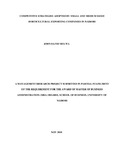| dc.contributor.author | Mulwa, John D | |
| dc.date.accessioned | 2013-03-18T08:20:04Z | |
| dc.date.issued | 2010 | |
| dc.identifier.citation | Master in Business Administration | en |
| dc.identifier.uri | http://erepository.uonbi.ac.ke:8080/xmlui/handle/123456789/14381 | |
| dc.description.abstract | Competitive strategies arise out of the need for organisations to position themselves to exploit opportunities and handle threats in the environment. This is geared to giving an organisation competitive advantage over its rivals and firms in the horticultural exporting sector are no exempt. Over the last decade the agricultural industry in Kenya has generally experienced low and declining productivity in terms of export earnings, employment creation, food security and household farm income. This is not the case in the Horticultural export sub sector where growth noted has arisen from continual growth and expansion of the small and medium (SME) sized companies which have not only expanded the Kenyan market abroad but also provided employment and supported the various sub sectors involved in the chain from growing to export.
Despite this positive growth, the horticulture export business’s future does not appear bright due to influx of many small exporters, increased competition from other upcoming countries especially those nearer the traditional markets of Europe, introduction of stringent new quality standards and legal requirements. This is in addition to the existing financial and technical barriers to the industry’s SME’s in upgrading their product lines and management systems given their limited resources. The study was conducted with the objective of determining the competitive strategies adopted by SME’s in the horticultural export industry in Kenya and the challenges these firms faced in development and implementation of these strategies. It was conducted by a survey of the SME’s in the horticultural export industry located in critical strategies used were those fostering quality and superb customer service (95% of respondents). Cost advantage was not seen by many as a sustainable competitive strategy as margins were already very slim in the industry with the many players both locally and globally.Differentiation was attained to a moderate extend with a mean of 3.3 out of 5 using this strategy. This could be attributed to the homogenous nature of products traded. Many of the players focused on particular markets (Mean of 3.8 out of 5)and concentrated on giving those markets their best within possible reach to maintain and grow their businesses. Challenges faced by many of the firms were similar with capital requirements (96%) and rapidly changing market requirements (88%) ranking at the top. Reduced industry profitability also posed a great challenge while government support was not well appreciated and policy makers need to prioritise this to foster growth in such a vital sector.
The Research focused only on SME’s in the horticultural export sector and further research can be done to determine strategies adopted and challenges facing the industry as whole. Another area of interest would be how current strategic decisions are influenced by the existing external environment and challenges of determining the fit between an organisation’s strategies and its external and internal environmental factors. This knowledge pool would contribute significantly to success of the horticultural sub sector and in turn growth of the Kenyan economy as a whole. | en |
| dc.description.sponsorship | The University of Nairobi | en |
| dc.language.iso | en | en |
| dc.subject | Small and medium sized Horticultural exporting companies in Nairobi | en |
| dc.title | Competitive strategies adopted by small and medium sized Horticultural exporting companies in Nairobi | en |
| dc.type | Thesis | en |
| local.publisher | School of Business | en |

